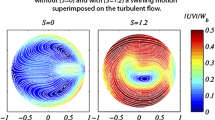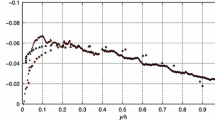Abstract
Error in measuring Reynolds shear-stress in turbulent boundary layer flows over a rough surface with a cross hot-wire has been reported in the literature and attributed to the existence of strong ejection and sweep motions that cause rectification, e.g. deviation of the velocity vector angle outside the acceptance cone of these probes. Using stereoscopic particle image velocimetry measurements and the concept of effective cooling velocities, the objective of the present study is to perform an a priori analysis of the cause of errors occurring when employing cross hot-wire anemometers. Besides the above-mentioned rectification effect, the role of the non-measured component is investigated. It is shown to be responsible for a non-negligible underestimation of the measured velocity variances and Reynolds shear-stress. This often overlooked source of error is intrinsic to turbulent flows and not limited to flow over rough walls.
Graphical abstract
Error analysis on the instantaneous shear-stress in the roughness sublayer of a rough boundary-layer measured by a (a) generic XHWA modeled using SPIV data : (c) influence of the non-measured component v, and relationships with Q-events (b) without and (d) with the non-measured component influence.









Similar content being viewed by others
References
Antonia RA, Djenidi L (2010) On the outer layer controversy for a turbulent boundary layer over a rough wall. In: Nickels TB (ed) IUTAM symposium on the physics of wall-bounded turbulent flows on rough walls. Springer, Dordrecht, pp 77–86
Basley J, Perret L, Mathis R (2018) Spatial modulations of kinetic energy in the roughness sublayer. J Fluid Mech 850:584–610
Blackman K, Perret L, Calmet I, Rivet C (2017) Turbulent kinetic energy budget in the boundary layer developing over an urban-like rough wall using PIV. Phys Fluids 29(085):113
Blackman K, Perret L, Savory E (2018) Effect of upstream flow regime and canyon aspect ratio on non-linear interactions between a street canyon flow and the overlying boundary layer. Bound Layer Meteorol. https://doi.org/10.1007/s10546-018-0378-y
Bruun HH (1995) Hot-wire anemometry, principles and signal analysis. Oxford Science Publications, Oxford
Castro IP, Cheng H, Reynolds R (2006) Turbulence over urban-type roughness: deductions from wind-tunnel measurements. Bound Layer Meteorol 118:109–131
Cheng H, Castro IP (2002) Near wall flow over urban like roughness. Bound Layer Meteorol 104:229–259
Coceal O, Dobre A, Thomas TG, Belcher SE (2007) Structure of turbulent flow over regular arrays of cubical roughness. J Fluid Mech 589:375–409
Djenidi L, Antonia RA, Amielh M, Anselmet F (2014) Use of PIV to highlight possible errors in hot-wire Reynolds stress data over a 2D rough wall. Exp Fluids 55(10):1830
Herpin S, Perret L, Mathis R, Tanguy C, Lasserre J (2018) Investigation of the flow inside an urban canopy immersed into an atmospheric boundary layer using laser doppler anemometry. Exp Fluids 59(5):80
Müller UR (1992) Comparison of turbulence measurements with single, X and triple hot-wire probes. Exp Fluids 13(2):208–216
Perret L, Ruiz T (2013) Spiv analysis of coherent structures in a vegetation canopy model flow. In: Venditti JG, Best J, Church M, Hardy RJ (eds) Coherent flow structures at Earth’s surface, chapter 11. Wiley-Blackwell, New York, pp 161–174
Perret L, Basley J, Mathis R, Piquet T (2018) Atmospheric boundary layers over urban-like terrains: influence of the plan density on the roughness sublayer dynamics. Bound Layer Meteorol (Accepted)
Perret L, Piquet T, Basley J, Mathis R (2017) Effects of plan area densities of cubical roughness elements on turbulent boundary layers. In: Congrès Français de Mécanique, pp 1–12. https://cfm2017.sciencesconf.org/130816. Accessed 28 Aug 2017
Reynolds RT, Castro IP (2008) Measurements in an urban-type boundary layer. Exp Fluids 45:141–156
Rivet C (2014) Etude en soufflerie atmosphérique des interactions entre canopée urbaine et basse atmosphère par PIV stéréoscopique. Ph.D. thesis, Ecole Centrale de Nantes
Tagawa M, Tsuji T, Nagano Y (1992) Evaluation of X-probe response to wire separation for wall turbulence measurements. Exp Fluids 12(6):413–421
Tutu NK, Chevray R (1975) Cross-wire anemometry in high intensity turbulence. J Fluid Mech 71(4):785–800
Author information
Authors and Affiliations
Corresponding author
Additional information
Publisher's Note
Publisher's Note Springer Nature remains neutral with regard to jurisdictional claims in published maps and institutional affiliations.
Rights and permissions
About this article
Cite this article
Perret, L., Rivet, C. A priori analysis of the performance of cross hot-wire probes in a rough wall boundary layer based on stereoscopic PIV. Exp Fluids 59, 153 (2018). https://doi.org/10.1007/s00348-018-2611-3
Received:
Revised:
Accepted:
Published:
DOI: https://doi.org/10.1007/s00348-018-2611-3




